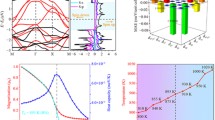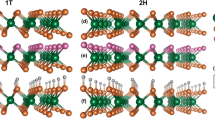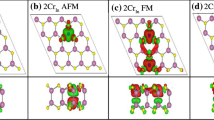Abstract
A Janus transition metal dichalcogenide’s structural, electronic, and magnetic properties in its two possible phases, namely CrSTe-1T and CrSTe-1H monolayer, are investigated using first-principles calculations. It is found that the CrSTe-1T monolayer is more stable than the CrSTe-1H monolayer by an amount of 0.4 eV at the equilibrium lattice constant. Due to the insurmountable energy barrier, diffusing the Te atom into the hexagon center in the CrSTe-1T monolayer is experimentally challenging. So, the CrSTe-1H monolayer is considered for further investigations, which has a hexagonal crystal structure. The calculated formation energy shows structural stability, while phonon dispersion indicates the kinetic stability of a Janus CrSTe-1H monolayer. Furthermore, the spin-polarized calculations show that the Janus CrSTe-1H monolayer is a non-magnetic semiconductor with a finite indirect electronic bandgap of 0.20 eV (\(\Gamma \) - M). However, applying a small biaxial tensile strain of 1.6%, the transition from non-magnetic to magnetic and semiconducting to half-metallic occurred. Further increasing the biaxial strain, the bandgap for the spin-down channel increases, and, interestingly, the half-metalicity is robust up to +10% biaxial tensile strain. In contrast, the bandgap increases with compressive strain up to \(-5 \%\) and then decreases up to \(-10 \%\), but no spin-polarization was induced. Furthermore, ferromagnetic (FM) and anti-ferromagnetic (AFM) interactions of a Janus CrSTe-1H monolayer were investigated. The calculated ΔE indicates that the AFM-1 (FM) state is more favorable under 0% (+6%) biaxial strain condition. The estimated exchange coupling parameter as \(J = 6.49\) meV under +6 \(\%\) biaxial strain results in near room-temperature ferromagnetism. Using the 2D Ising model, the Curie temperature (\(T_c\)) of 274.85 K for a Janus CrSTe-1H monolayer is estimated at \(+6 \%\) biaxial strain. These calculations predict that the 2D Janus CrSTe-1H monolayer is a candidate for electronic, spintronic, and photovoltaic devices. For example, for photovoltaic applications, the optical absorption is calculated. The optical absorption is about 10–20%, indicating larger absorption, so the Janus CrSTe-1H monolayer is a good sunlight harvester for photovoltaic applications.
Graphical Abstract
A Janus transition metal dichalcogenide’s structural, electronic, and magnetic properties in its two possible phases, namely CrSTe-1T and CrSTe-1H monolayer, are investigated using first-principles calculations. The spin-polarized calculations show that the Janus CrSTe-1H monolayer is a non-magnetic semiconductor with a finite indirect electronic bandgap of 0.20 eV (\(\Gamma \) - M). However, applying a small biaxial tensile strain of 1.6%, the transition from non-magnetic to magnetic and semiconducting to half-metallic occurred. Furthermore, ferromagnetic (FM) and anti-ferromagnetic (AFM) interactions of a Janus CrSTe-1H monolayer were investigated. The calculated \(\triangle \)E indicates that the AFM-1 (FM) state is more favorable under 0% (+6%) biaxial strain condition. The estimated exchange coupling parameter as \(J = 6.49\) meV under +6% biaxial strain results in near room-temperature ferromagnetism. Using the 2D Ising model, the Curie temperature (T\(_c\)) of 274.85 K for a Janus CrSTe-1H monolayer is estimated at +6% biaxial strain. These calculations predict that the 2D Janus CrSTe-1H monolayer is a candidate for electronic, spintronic, and photovoltaic devices. For example, for photovoltaic applications, the optical absorption is calculated. The optical absorption is about 10–20%, indicating larger absorption, so the Janus CrSTe-1H monolayer is a good sunlight harvester for photovoltaic applications.










Similar content being viewed by others
Data Availability
The data that support the findings of this study are available from the corresponding author upon reasonable request.
References
K.F. Mak, C. Lee, J. Hone, J. Shan, T.F. Heinz, Atomically thin MoS2: a new direct-gap semiconductor. Phys. Rev. Lett. 105(13), 136805 (2010)
H.P. Komsa, A.V. Krasheninnikov, Effects of confinement and environment on the electronic structure and exciton binding energy of MoS2 from first principles. Phys. Rev. B 86(24), 241201 (2012)
K.F. Mak, K. He, C. Lee, G.H. Lee, J. Hone, T.F. Heinz, J. Shan, Tightly bound trions in monolayer MoS2. Nat. Mater. 12(3), 207–211 (2013)
J. Zhang, J. Li, Z. Wang, X. Wang, W. Feng, W. Zheng, W. Cao, P. Hu, Low-temperature growth of large-area heteroatom-doped graphene film. Chem. Mater. 26(7), 2460–2466 (2014)
A. Kuc, N. Zibouche, T. Heine, Influence of quantum confinement on the electronic structure of the transition metal sulfide TS2. Phys. Rev. B 83(24), 245213 (2011)
P. Blake, E. Hill, A. Castro Neto, K. Novoselov, D. Jiang, R. Yang, T. Booth, A. Geim, Making graphene visible. Appl. Phys. Lett. 91(6), 063124 (2007)
A.C. Neto, F. Guinea, N.M. Peres, K.S. Novoselov, A.K. Geim, The electronic properties of graphene. Rev. Mod. Phys. 81(1), 109 (2009)
M. Ezawa, Monolayer topological insulators: silicene, germanene, and stanene. J. Phys. Soc. Jpn. 84(12), 121003 (2015)
Q. Zhang, Z. Ren, N. Wu, W. Wang, Y. Gao, Q. Zhang, J. Shi, L. Zhuang, X. Sun, L. Fu, Nitrogen-doping induces tunable magnetism in ReS\(_2\). Npj 2D Mater. Appl. 2(1), 1–8 (2018)
H.L. Zhuang, M.D. Johannes, M.N. Blonsky, R.G. Hennig, Computational prediction and characterization of single-layer CrS\(_2\). Appl. Phys. Lett. 104(2), 022116 (2014)
A.B. Maghirang, Z.-Q. Huang, R.A.B. Villaos, C.-H. Hsu, L.-Y. Feng, E. Florido, H. Lin, A. Bansil, F.-C. Chuang, Predicting two-dimensional topological phases in Janus materials by substitutional doping in transition metal dichalcogenide monolayers. Npj 2D Mater. Appl. 3(1), 1–8 (2019)
G.S. Khosa, S. Gupta, R. Kumar, First-principles investigations of electronic and thermoelectric properties of Janus Al2SSe monolayer. Phys. B 615, 413057 (2021)
C. Ataca, H. Sahin, S. Ciraci, Stable, single-layer MX2 transition-metal oxides and dichalcogenides in a honeycomb-like structure. J. Phys. Chem. C 116(16), 8983–8999 (2012)
H.L. Zhuang, R.G. Hennig, Electronic structures of single-layer boron pnictides. Appl. Phys. Lett. 101(15), 153109 (2012)
H.L. Zhuang, A.K. Singh, R.G. Hennig, Computational discovery of single-layer iii–v materials. Phys. Rev. B 87(16), 165415 (2013)
H.L. Zhuang, R.G. Hennig, Computational identification of single-layer CdO for electronic and optical applications. Appl. Phys. Lett. 103(21), 212102 (2013)
G. Rahman, A.U. Rahman, S. Kanwal, P. Kratzer, Magnetic monolayer Li2N: density functional theory calculations. EPL (Europhysics Letters) 119(5), 57002 (2017)
A. Acun, L. Zhang, P. Bampoulis, Mv. Farmanbar, A. van Houselt, A. Rudenko, M. Lingenfelder, G. Brocks, B. Poelsema, M. Katsnelson, H.J.W. Zandvliet, Germanene: the germanium analogue of graphene. J. Phys.: Condens. Matter 27(44), 443002 (2015)
C. Kamal, M. Ezawa, Arsenene: Arsenene: two-dimensional buckled and puckered honeycomb arsenic systems. Phys. Rev. B 91(8), 085423 (2015)
A.U. Rahman, G. Rahman, P. Kratzer, Enhanced electronic and magnetic properties by functionalization of monolayer GaS via substitutional doping and adsorption. J. Phys.: Condens. Matter 30(19), 195805 (2018)
C. Tan, X. Cao, X.J. Wu, Q. He, J. Yang, X. Zhang, J. Chen, W. Zhao, S. Han, G.H. Nam, M. Sindoro, Recent advances in ultrathin two-dimensional nanomaterials. Chem. Rev. 117(9), 6225–6331 (2017)
C. Si, Z. Sun, F. Liu, Strain engineering of graphene: a review. Nanoscale 8(6), 3207–3217 (2016)
Y. Shao, F. Zhang, X. Shi, H. Pan, N-functionalized MXenes: ultrahigh carrier mobility and multifunctional oroperties. Phys. Chem. Chem. Phys. 19(42), 28710–28717 (2017)
D.L. Duong, S.J. Yun, Y.H. Lee, van der Waals layered materials: opportunities and challenges. ACS Nano 11(12), 11803–11830 (2017)
G. Gao, G. Ding, J. Li, K. Yao, M. Wu, M. Qian, Monolayer MXenes: promising half-metals and spin gapless semiconductors. Nanoscale 8(16), 8986–8994 (2016)
C. Gong, L. Li, Z. Li, H. Ji, A. Stern, Y. Xia, T. Cao, W. Bao, C. Wang, Y. Wang, Z.Q. Qiu, Discovery of intrinsic ferromagnetism in two-dimensional van der Waals Crystals. Nature 546(7657), 265–269 (2017)
B. Huang, G. Clark, E. Navarro-Moratalla, D.R. Klein, R. Cheng, K.L. Seyler, D. Zhong, E. Schmidgall, M.A. McGuire, D.H. Cobden, W. Yao, D. Xiao, P. Jarillo-Herrero, X. Xu, Layer-dependent ferromagnetism in a van der Waals Crystal down to the monolayer limit. Nature 546(7657), 270–273 (2017)
N. Miao, B. Xu, L. Zhu, J. Zhou, Z. Sun, 2D intrinsic ferromagnets from van der Waals Antiferromagnets. J. Am. Chem. Soc. 140(7), 2417–2420 (2018)
Y. Li, Z. Zhou, S. Zhang, Z. Chen, MoS2 nanoribbons: high stability and unusual electronic and magnetic properties. J. Am. Chem. Soc. 130(49), 16739–16744 (2008)
Y. Wang, S.-S. Wang, Y. Lu, J. Jiang, S.A. Yang, Strain-induced isostructural and magnetic phase transitions in monolayer MoN2. Nano Lett. 16(7), 4576–4582 (2016)
Y.L. Huang, W. Chen, A.T. Wee, Two-dimensional magnetic transition metal chalcogenides. SmartMat 2(2), 139–153 (2021)
A.V. Kuklin, A.A. Kuzubov, E.A. Kovaleva, N.S. Mikhaleva, F.N. Tomilin, H. Lee, P.V. Avramov, Two-dimensional hexagonal CrN with promising magnetic and optical properties: a theoretical prediction. Nanoscale 9(2), 621–630 (2017)
L. Hu, X. Wu, J. Yang, Mn2C monolayer: a 2d antiferromagnetic metal with high neel temperature and large spin-orbit coupling. Nanoscale 8(26), 12939–12945 (2016)
F. Li, W. Wei, P. Zhao, B. Huang, Y. Dai, Electronic and optical properties of pristine and vertical and lateral heterostructures of Janus MoSSe and WSSe. J. Phys. Chem. Lett. 8(23), 5959–5965 (2017)
X. Tang, S. Li, Y. Ma, A. Du, T. Liao, Y. Gu, L. Kou, Distorted Janus transition metal dichalcogenides: stable two-dimensional materials with sizable band gap and ultrahigh carrier mobility. J. Phys. Chem. C 122(33), 19153–19160 (2018)
H. Jin, T. Wang, Z.-R. Gong, C. Long, Y. Dai, Prediction of an extremely long exciton lifetime in a Janus-MoSTe monolayer. Nanoscale 10(41), 19310–19315 (2018)
Z. Guan, S. Ni, S. Hu, Tunable electronic and optical properties of monolayer and multilayer Janus MoSSe as a photocatalyst for solar water splitting: a first-principles study. J. Phys. Chem. C 122(11), 6209–6216 (2018)
Y. Hou, F. Xue, L. Qiu, Z. Wang, R. Wu, Multifunctional two-dimensional van der Waals Janus magnet Cr-based dichalcogenide halides. Npj Comput. Mater. 8(1), 1–6 (2022)
J. Wang, S.U. Rehman, Z. Tariq, X. Zhang, J. Zheng, F.K. Butt, C. Li, Pristine and Janus chromium dichalcogenides: potential photocatalysts for overall water splitting in wide solar spectrum under strain and electric field. Sol. Energy Mater. Sol. Cells 230, 111258 (2021)
Q. Cui, J. Liang, Z. Shao, P. Cui, H. Yang, Strain-tunable ferromagnetism and chiral spin textures in two-dimensional Janus chromium dichalcogenides. Phys. Rev. B 102(9), 094425 (2020)
D.C. Freitas, R. Weht, A. Sulpice, G. Remenyi, P. Strobel, F. Gay, J. Marcus, M. Núñez-Regueiro, Ferromagnetism in layered metastable 1T-CrTe2. J. Phys.: Condens. Matter 27(17), 176002 (2015)
X. Sun, W. Li, X. Wang, Q. Sui, T. Zhang, Z. Wang, L. Liu, D. Li, S. Feng, S Zhong, Z. Zhang, Room temperature ferromagnetism in ultra-thin van der Waals Crystals of 1T-CrTe2. Nano Res. 13(12), 3358–3363 (2020)
P. Hohenberg, W. Kohn, Inhomogeneous electron gas. Phys. Rev. 136(3B), B864 (1964)
W. Kohn, L.J. Sham, Self-consistent equations including exchange and correlation effects. Phys. Rev. 140(4A), A1133 (1965)
P. Giannozzi, S. Baroni, N. Bonini, M. Calandra, R. Car, C. Cavazzoni, D. Ceresoli, G.L. Chiarotti, M. Cococcioni, I. Dabo, A. Dal Corso, Quantum espresso: a modular and open-source software project for quantum simulations of materials. J. Phys. Condensed Matter. 21(39), 395502 (2009)
J.P. Perdew, K. Burke, M. Ernzerhof, Generalized gradient approximation made simple. Phys. Rev. Lett. 77(18), 3865 (1996)
S. Grimme, Semiempirical GGA-type density functional constructed with a long-range dispersion correction. J. Comput. Chem. 27(15), 1787–1799 (2006)
H.J. Monkhorst, J.D. Pack, Special points for Brillouin-zone integrations. Phys. Rev. B 13(12), 5188 (1976)
A. Togo, F. Oba, I. Tanaka, First-principles calculations of the ferroelastic transition between rutile-type and CaCl2-type SiO2 at high pressures. Phys. Rev. B 78(13), 134106 (2008)
O. Madelung, U. Rossler, M. Schulz, Non-Tetrahedrally Bonded Elements and Binary Compounds, vol. 41 (Springer, 1998)
A.C. Neto, F. Guinea, N.M. Peres, K.S. Novoselov, A.K. Geim, The electronic properties of graphene. Rev. Mod. Phys. 81(1), 109 (2009)
H. Sevinçli, M. Topsakal, S. Ciraci, Superlattice structures of graphene-based armchair nanoribbons. Phys. Rev. B 78(24), 245402 (2008)
W. Shi, Z. Wang, Mechanical and electronic properties of Janus monolayer transition metal dichalcogenides. J. Phys.: Condens. Matter 30(21), 215301 (2018)
S.-Y. Yang, D.-R. Shi, T. Wang, X.-Y. Yue, L. Zheng, Q.-H. Zhang, L. Gu, X.-Q. Yang, Z. Shadike, L. Hong, Z.-W. Fu, High-rate cathode CrSSe based on Anion reactions for lithium-ion batteries. J. Mater. Chem. A 8(48), 25739–25745 (2020)
F.A. Rasmussen, K.S. Thygesen, Computational 2d materials database: electronic structure of transition-metal dichalcogenides and oxides. J. Phys. Chem. C 119(23), 13169–13183 (2015)
A.U. Rahman, H. Ullah, A. Jamil, Z. Iqbal, M. Naveed-Ul-Haq, Robust ferromagnetism and half-metallicity in hydrogenated monolayer-CdS. Phys. B 570, 209–216 (2019)
M.A. Lukowski, A.S. Daniel, F. Meng, A. Forticaux, L. Li, S. Jin, Enhanced hydrogen evolution catalysis from chemically exfoliated metallic MoS2 nanosheets. J. Am. Chem. Soc. 135(28), 10274–10277 (2013)
G. Eda, H. Yamaguchi, D. Voiry, T. Fujita, M. Chen, M. Chhowalla, Photoluminescence from chemically exfoliated MoS2. Nano Lett. 11(12), 5111–5116 (2011)
H.J. Conley, B. Wang, J.I. Ziegler, R.F. Haglund Jr., S.T. Pantelides, K.I. Bolotin, Bandgap engineering of strained monolayer and bilayer MoS2. Nano Lett. 13(8), 3626–3630 (2013)
R. Fei, W. Li, J. Li, L. Yang, Giant piezoelectricity of monolayer group IV monochalcogenides: SnSe, SnS, GeSe, and GeS. Appl. Phys. Lett. 107(17), 173104 (2015)
W. Yu, Z. Zhu, S. Zhang, X. Cai, X. Wang, C.-Y. Niu, W.-B. Zhang, Tunable electronic properties of GESE/phosphorene heterostructure from first-principles study. Appl. Phys. Lett. 109(10), 103104 (2016)
M.E. Fisher, R.J. Burford, Theory of critical-point scattering and correlations. I. The ISING model. Phys. Rev. 156(2), 583 (1967)
W. Shockley, H.J. Queisser, Detailed balance limit of efficiency of p-n junction solar cells. J. Appl. Phys. 32(3), 510–519 (1961)
M. Bernardi, M. Palummo, J.C. Grossman, Extraordinary sunlight absorption and one nanometer thick photovoltaics using two-dimensional monolayer materials. Nano Lett. 13(8), 3664–3670 (2013)
R.R. Nair, P. Blake, A.N. Grigorenko, K.S. Novoselov, T.J. Booth, T. Stauber, N.M.R. Peres, A.K. Geim, Fine structure constant defines visual transparency of graphene. Science 320, 1308 (2008)
Acknowledgements
This work was supported in part by Oracle Cloud credits and related resources provided by the Oracle for Research program (Award Number CPQ-2652238). A. U. Rahman acknowledges the Super-Computing facility at Ghulam Ishaq Khan Institute of Engineering Sciences and Technology funded by the Directorate of Science and Technology (DoST), Government of Khyber Pakhtunkhwa. A. U. Rahman also acknowledges the Super-Computing facility at National Center for Physics (NCP) Islamabad, Pakistan.
Author information
Authors and Affiliations
Contributions
A. U. Rahman Literature review and theoretical calculations, computational methodology and plotting, writing - review, supervision, conceptualization, check & editing, Project administration.
Corresponding author
Ethics declarations
Conflict of interest
The authors declare that they have no conflict of interest.
Additional information
Publisher's Note
Springer Nature remains neutral with regard to jurisdictional claims in published maps and institutional affiliations.
Supplementary Information
Below is the link to the electronic supplementary material.
Rights and permissions
Springer Nature or its licensor (e.g. a society or other partner) holds exclusive rights to this article under a publishing agreement with the author(s) or other rightsholder(s); author self-archiving of the accepted manuscript version of this article is solely governed by the terms of such publishing agreement and applicable law.
About this article
Cite this article
Rahman, A.U. Strain Induces Ferromagnetism in a Janus Transition Metal Dichalcogenides: CrSTe-1H Monolayer. J. Electron. Mater. 52, 1036–1049 (2023). https://doi.org/10.1007/s11664-022-10075-1
Received:
Accepted:
Published:
Issue Date:
DOI: https://doi.org/10.1007/s11664-022-10075-1




